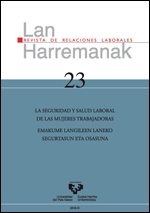Prevención de riesgos laborales, igualdad entre mujeres y hombres y negociación colectiva en la CAV
##plugins.themes.bootstrap3.article.main##
##plugins.themes.bootstrap3.article.sidebar##
Abstract
The aim of this work is to inquire into relationships existing between the prevention of risks at work and the interdiction of discrimination on grounds of sex in the workplace. It also attempts to analyse the role played by collective bargaining in establishing a preventive policy in companies which assumes the standpoint of equal opportunities in the workplace among men and women. To this end, the text is divided into two sections: the first describes the relationships existing between the prevention of risks at work and equal opportunities among men and women. The second one takes a more systematic look at the gaps not covered by the regulations currently in force, in addition to the terms of reference for which purpose collective bargaining plays a part in promoting a preventive policy inspired by equality among men and women.
How to Cite
##plugins.themes.bootstrap3.article.details##
Authors who publish in the journal "Lan Harremanak" do so in agreement with the following terms:
1. Authors retain the copyright of their papers. while ceding to the journal "Lan Harremanak" the right to the first publication of their article.
2. The publisher UPV/EHU Press is a joint copyright holder, in order to protect the legitimate use of the published paper and compliance with CC terms.
3. Published papers are subject to a Creative Commons CC-BY license (unless stated otherwise) which permits third parties to share the paper, on the condition that the author and source are specified when material is reproduced.
4. Authors can enter into other non-exclusive license agreements regarding the published version of their work (e.g. depositing it in an institutional repository or re-publishing it as a monographic volume), providing the author and source are given appropriate credit.
5. Dissemination of submitted articles via Internet is both allowed and recommended (e.g. in institutional repositories and/or on the researcher's web page), both before and during the process of submission, since this can lead to interesting dialogues and also increase citations to the eventual publication.

